How many people do we grant asylum or protection to?
Updated 26 August 2021
Back to ‘Immigration statistics, year ending June 2021’ content page.
This is not the latest release. View latest release.
Data relate to the year ending June 2021 and all comparisons are with the year ending June 2020, unless indicated otherwise.
On 11 March 2020, the World Health Organisation (WHO) declared the COVID-19 outbreak as a global pandemic. A range of restrictions were implemented in many parts of the world, and the first UK lockdown measures were announced on 23 March 2020. The COVID-19 pandemic has had a significant impact on the UK immigration system, both in terms of restricting migrant movements to and from the UK and the impact on operational capacity.
Year ending comparisons that follow will include impacts resulting from the restrictions put in place during this period of the pandemic.
This section contains data on:
- Asylum applications and initial decisions, including unaccompanied asylum-seeking children (UASC)
- Resettlement
- Family reunion visas granted
- Outcomes of asylum applications
- Asylum support
- Inadmissibility
An asylum application may relate to more than one person, if the applicant has family members (or ‘dependants’) which they request to be covered by the same application. This release features data on both the number of asylum applications or initial decisions (‘main applicants only’), and the number of people related to asylum applications and initial decisions (‘main applicants and dependants’).
Statistics on the number of applications and decisions of those applying to enter or remain in the UK under the new Hong Kong British Nationals (Overseas) route are included in the ‘How many people come to the UK each year (including visitors)’ section.
1. People granted protection and other leave through asylum and resettlement routes
This section covers individuals granted leave to remain in the UK via three routes: applying for asylum, resettlement, and family reunion visas.
The UK offered protection, in the form of asylum, humanitarian protection, alternative forms of leave and resettlement, to 10,725 people (including dependants) in the year ending June 2021. Of these:
- 82% were granted refugee status following an asylum application (‘asylum’)
- 8% were granted humanitarian protection
- 4% were granted alternative forms of leave (such as discretionary leave, UASC leave)
- 6% were granted refugee status through resettlement schemes, although this proportion was lower than in recent years due to measures taken as a result of the COVID-19 pandemic
Additionally, 6,449 partners and children of refugees living in the UK were granted entry to the UK through family reunion visas, 2% more than the previous year.
Figure 1: People granted1 asylum, alternative forms of leave2, and resettlement3 in the UK, years ending June 2011 to June 20214
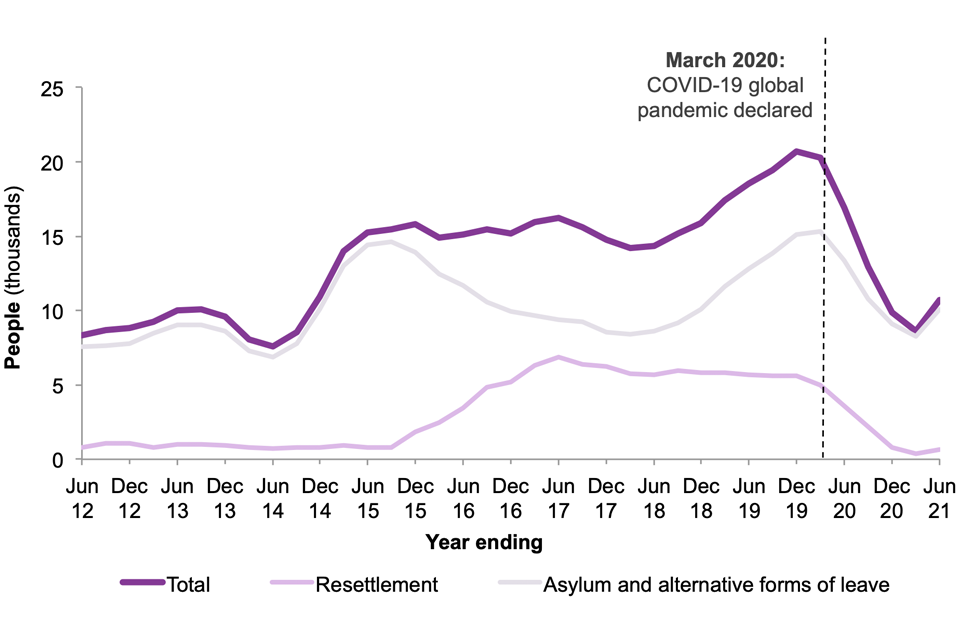
Source: Asylum applications, initial decisions and resettlement – Asy_D02
Notes:
- The data are for grants at initial decision. The final number of grants following appeal will be higher.
- In this chart, ‘Alternative forms of leave’ include grants of humanitarian protection, discretionary leave, grants under family and private life rules, leave outside the rules and UASC leave, that resulted from an asylum application.
- Resettlement data prior to 2013 are only available annually. Data for individual quarters in this period have been estimated by taking 25% of the annual total.
- Includes main applicants and dependants.
Figure 1 shows that following the ‘European migration crisis’ in 2015-16, the number of people granted protection rose, reaching around 20,000 in the year ending March 2020, before falling sharply from March 2020 onwards after the start of the COVID-19 pandemic. The number of grants increased in the most recent quarter but has not returned to pre-pandemic levels.
The number of people offered protection in the year ending June 2021 decreased by 37% from the previous year. This fall is due to fewer initial decisions being made on asylum applications (13,929 decisions compared with 18,239 in the previous year), as well as the pause to resettlement activity between March and November 2020, both impacted by the COVID-19 pandemic.
The data in this section includes those granted asylum or alternative forms of leave at initial decision following an asylum application. However, there will be additional people who receive a grant of protection following an appeal against an initial refusal (see sections below on outcomes and appeals).
1.1 Resettlement
There were 661 people granted protection through resettlement schemes in the year ending June 2021. This is 81% fewer than in the previous year, due to resettlement activity being paused between March and November 2020, as a result of the COVID-19 pandemic.
In the year ending June 2021:
-
47% were resettled through the UK Resettlement scheme (UKRS), and 4% through Community Sponsorship
-
the most common nationalities of those resettled were Syria (82%), Iraq (5%) and Sudan (5%)
-
since the first arrivals in March 2021, 310 refugees have been resettled in the UK via the UKRS
More information about current and previous resettlement schemes can be found in the user guide.
This section does not include the resettlement of over 3,300 Afghan staff (and their families) who have supported British efforts in Afghanistan, since 2013. For further information, see the GOV.UK Factsheet on the resettlement of Afghan nationals.
2. Asylum applications
There were 31,115 asylum applications (relating to 37,235 people) in the UK in the year ending June 2021, 4% fewer than the previous year. There were 2,756 applications from Unaccompanied asylum seeking children (UASC), 15% fewer than the previous year.
The decrease in applications is likely linked in part to the global travel restrictions implemented in response to the COVID-19 pandemic, which have impacted migrants’ movements globally and arrivals into the UK. Applications fell substantially in 2020 Q2, following the initial COVID-19 outbreak. Although they have increased since, they remain below the levels seen prior to the outbreak - there were 8,768 applications for asylum in Q2 2021, 15% fewer applications than the same period in 2019, but 79% higher when compared to the same period in 2020).
Figure 2: Asylum applications lodged in the UK, years ending June 2012 to June 2021 1
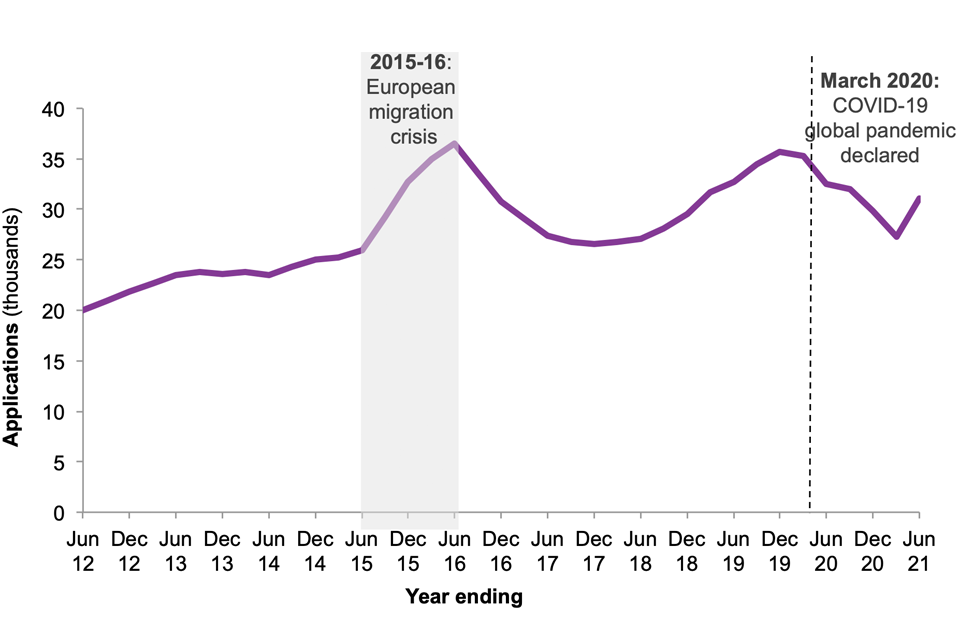
Source: Asylum applications, initial decisions and resettlement – Asy_D01
Notes:
- Main applicants only.
Figure 2 shows that asylum applications rose from 2012 to 2016, rising more rapidly during the peak of the European Migration crisis (2015-16). Applications fell from mid-2016 but rose again in 2018 and by March 2020 had reached levels similar to the Migration crisis of 2015-16. Applications fell following the onset of the global pandemic. Although they have increased since the initial outbreak, they remain below pre-pandemic levels.
Figure 3: Top 10 nationalities1 claiming asylum in the UK and grant rate2 at initial decision (%), years ending June 2020 and June 2021

Source: Asylum applications, initial decisions and resettlement – Asy_D01 and Asy_D02
Notes:
-
Top 10 nationalities in the most recent year (excluding Stateless); main applicants only.
-
The percentages in the chart are the grant rate at initial decision for each nationality in the most recent year. Grant rate is the proportion of initial decisions which resulted in a grant of protection or other leave. Grant rate is based on year of initial decision and is not directly comparable to applications, which are based on the date the asylum application was made.
Iran was the top nationality claiming asylum in the UK in the year ending June 2021 (3,795 applications), as it has been in every year since 2016, although the number of Iranian applicants was lower (down 18%) in the latest year.
Figure 3 shows the number of applications decreased for four of the top 10 nationalities applying for asylum in the UK. Of the top 10 nationalities, five experienced an increase – Albania (up 10%), Vietnam (up 22%), Syria (up 55%), Eritrea (up 72%), and Sudan (up 77%).
Table 1: Proportion of asylum main applicants by age and sex in year ending June 2021.
| Age | Male | Female |
|---|---|---|
| Under 18 | 8% | 1% |
| 18-29 | 44% | 8% |
| 30-49 | 27% | 8% |
| 50-69 | 2% | 2% |
| 70+ | <1% | <1% |
Source: Asylum applications, initial decisions and resettlement – Asy_D01
Table 1 shows the most common demographic of asylum applicants were males aged between 18-29, accounting for 44% of total applicants in the latest year. The age and sex demographics vary by nationality, for example 60% of applications from Sudanese nationals were from males aged 18-29 compared to 37% of applications from Pakistani nationals of the same age and sex. Of the applications received from Albanian and Eritrean nationals, 13% were from females aged 18-29, compared to the average of 8% across all nationalities.
2.1 International comparisons
The fall in UK asylum applications was similar to the trends seen more widely across Europe. The number of people (including dependants) claiming asylum in the EU+ (countries in the EU, EEA and Switzerland) decreased by 38%, and in the UK decreased by 27% in the year ending March 2021 (the latest available comparable statistics).
In the year ending March 2021, Germany received the highest number of asylum applicants (129,985) in the EU+, followed by France (86,340). When compared with the EU+ member states for the year ending March 2021, the UK received the 4th largest number of applicants (33,046). This equates to 7% of the total asylum applicants across the EU+ and UK combined over that period, or the 17th largest intake when measured per head of population.
Figure 4: The number of asylum applicants to the top five countries1 in the EU+ and the UK, year ending March 2017 – March 20212,3,4

Source: Eurostat Asylum statistics, Asylum applications, initial decisions and resettlement – Asy_D01 and Asy_D02
Notes:
-
Top 5 countries in the EU+ receiving asylum applicants in the most recent year.
-
Includes main applicants and dependants.
-
The ‘Other EU+’ category includes all other countries that are European Union member states, part of the European Economic Area, and Switzerland.
-
Data for the UK is sourced from Eurostat for year ending March 2017-2020, and then Home Office data for year ending March 2021.
Figure 4 shows between the year ending March 2017 and March 2020, applications to Germany and Italy have dropped, while France, Spain and Greece saw increases. The number of applications to the UK has remained fairly stable in comparison to these top 5 receiving countries. There was a drop in applications for all countries in year ending March 2021, when compared to the previous year, in part due to COVID-19.
Please note that Eurostat data are not directly comparable with Home Office Immigration Statistics data. Eurostat figures combine main applicants and dependants, and as such that is how the data for both the UK and EU+ have been presented in this section (2.1). For a full list of differences between Eurostat and Home Office asylum statistics, see the user guide.
3. Outcomes of asylum applications
3.1 At initial decision
In the year ending June 2021, there were 13,929 initial decisions made on asylum applications. The number of decisions was 24% fewer than the previous year, in part as a result of the COVID-19 pandemic. Although the number of decisions made has increased in the latest two quarters, the numbers remain below levels seen before the pandemic.
Over half (55%) of the initial decisions in the year ending June 2021 were grants of asylum, humanitarian protection or alternative forms of leave. The proportion of grants is slightly higher than the previous year (53%), and higher than levels prior to 2019, when around a third of initial decisions were grants.
The overall grant rate can vary for a number of reasons, including the protection needs of those who claim asylum in the UK, along with operational or policy decisions. Grant rates vary considerably by nationality as the protection needs of specific groups or individuals differ, usually depending on the situation in their home country. Of nationalities that commonly claim asylum in the UK, Libyans (95%) and Syrians (88%) typically have high grant rates at initial decision, while nationals of India (6%), Philippines (15%), and China (19%) have low grant rates (see Figure 3).
3.2 At appeal
Some initial decisions (mainly, but not entirely, refusals) will go on to be appealed.
There were 4,392 appeals lodged on initial decisions in the year ending June 2021. This is 39% fewer than the previous year, in part reflecting the smaller number of applications received and processed due to the pandemic, but this continues a downward trend for numbers of appeals lodged since 2015.
Of the appeals resolved in the year ending June 2021, almost half (48%) were allowed (meaning the applicant successfully overturned the initial decision). The proportion of appeals allowed has risen from 29% in 2010, when the timeseries began.
3.3 Final outcomes
This section shows the final outcomes of asylum applications, following an appeal. A proportion of outcomes may change following further submissions from applicants; such changes to outcomes are not reflected in this section.
Of those who applied for asylum in the UK in 2020, 23,188 cases (78%) were currently awaiting an outcome. For this reason, the analysis below focuses on the outcomes for applications made before 2020. As more initial decisions are made, and more appeals completed, the number of grants and refusals for applications from all years (but particularly more recent years) will increase, and this will be reported in future statistics.
Figure 5: Outcomes of asylum applications with a known initial decision, 2017 to 20191,2,3
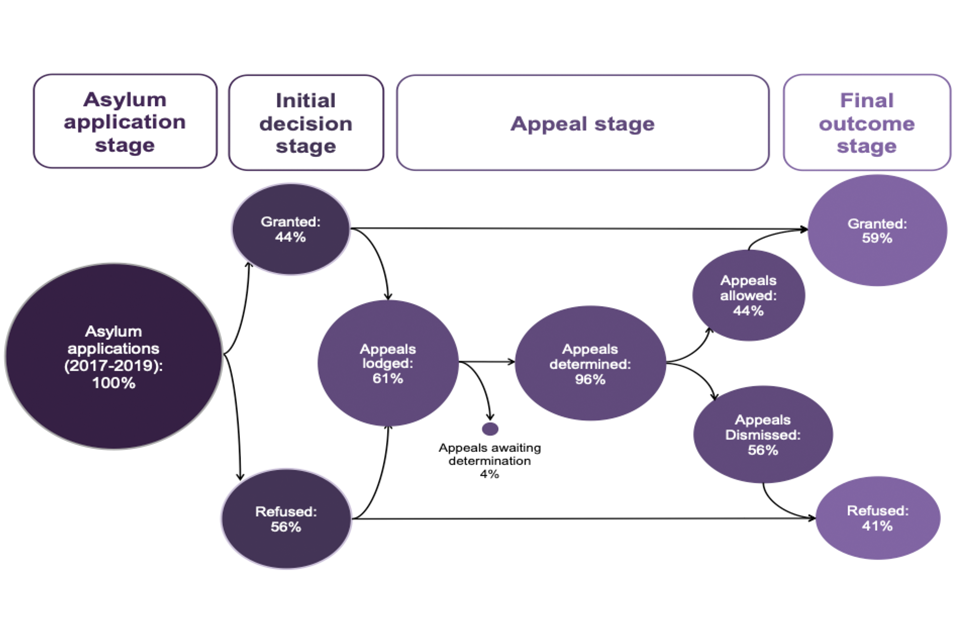
Source: Asylum tables – Outcome analysis of asylum applications
Notes:
-
Data include all asylum applications where the application raised date was between 2017 and 2019 and have received an initial decision. Cases where the initial or final decision is unknown, or where the application was withdrawn, are not included in this analysis.
-
Grant rates shown here relate to the decisions of total applications made in each cohort year excluding withdrawals.
-
Appeals lodged are presented as a proportion of all initial decisions (except grants of asylum, which would not be appealed); the majority of these relate to refusals, although a small number of other initial decisions may also result in an appeal. It only includes appeals lodged by the asylum applicant at the First-tier Tribunal (Immigration and Asylum Chamber).
Figure 5 shows that, of those applications received between 2017 and 2019, 44% were granted at initial decision. Of those who were refused asylum at initial decision, 61% lodged an appeal against the decision. Of the appeals lodged, 44% of appeals were allowed and 56% were dismissed. As a result, the grant rate for all applications for asylum made between 2017 and 2019 increased from 44% at initial decision to 59% following appeal.
Figure 6: Final outcome of asylum applications, by type of outcome1,2, 2008 – 2020
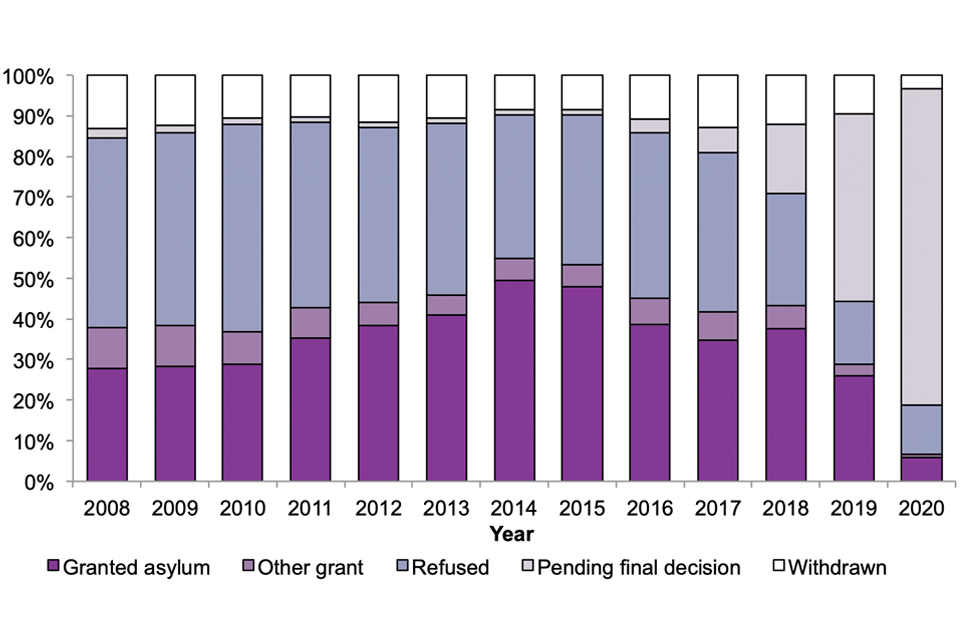
Source: Asylum tables – Outcome analysis of asylum applications
Notes:
-
Data are based on date of application, and the outcomes are as at the point of data extraction in May 2021.
-
The proportion of applications awaiting an outcome (either an initial decision or an appeal) will be lower in earlier years as more time has elapsed for the cases to be processed than those from more recent years.
Figure 6 shows for each year the proportion of final outcomes for applications made in each year between 2008 and 2020. The most recent years have a higher proportion of cases still pending a final outcome.
The overall grant rate where a final outcome has been reached was estimated to be 27% in 2004; but this proportion steadily increased, reaching 65% for applications made in 2019. The grant rate for 2020 is currently around 35%, however the proportion of applications awaiting an outcome (either an initial decision or an appeal) is much lower for more recent years as less time has elapsed for the cases to be completed, making any comment on the overall trend for these years provisional.
3.4 Applications awaiting outcomes
At the end of June 2021, there were 56,617 cases (relating to 70,905 people) awaiting an initial decision. The number of cases awaiting an initial decision has shown an overall increase in the last ten years, and more rapidly since 2018.
Data on the total number of cases in the asylum system (‘asylum work in progress’), including cases awaiting appeal outcomes and failed asylum seekers that are subject to removal from the UK, is published in the ‘Immigration and Protection’ data of the Migration Transparency Data collection. The latest data available (for the end of June 2021) shows a total of 125,316 cases in the ‘work in progress’.
4. Support provided to asylum seekers
Support is the provision of accommodation and/or subsistence to those in the asylum system.
At the end of June 2021, there were 62,871 individuals in receipt of support. Of these:
-
74% were in receipt of Section 95 support, provided to destitute asylum seekers while they await a decision on their asylum application
-
17% were in receipt of Section 98 support, provided to destitute asylum seekers who are awaiting a decision on their Section 95 application, or have been approved for Section 95 support and are awaiting transfer to their dispersal accommodation
-
9% were in receipt of Section 4 support, provided to individuals whose asylum application has been refused but they are destitute and there are reasons that temporarily prevent them from leaving the UK
Table 2: Number of individuals in receipt of support.
| As at June 2020 | As at June 2021 | Change | % change | |
|---|---|---|---|---|
| Section 95 | 45,769 | 46,254 | +485 | +1% |
| Section 98 | 5,444 | 10,682 | +5,238 | +96% |
| Section 4 | 5,357 | 5,935 | +578 | +11% |
| Total | 56,570 | 62,871 | +6,301 | +11% |
Source: Asylum seekers in receipt of support – ASY_D09
Table 2 shows a sharp increase in the number of individuals receiving support under Section 98. This increase is likely related to COVID-19 and the use of temporary hotels to house asylum seekers during COVID-19.
4.1 Support by local authority
Of the 46,254 asylum seekers receiving Section 95 support, 8% have a registered address in Glasgow City. This is the highest of all local authorities and equivalent to just under 56 asylum seekers per ten thousand residents.
Figure 7 shows that the areas with the highest proportion of asylum seekers (31+ asylum seekers per ten thousand population) are Glasgow City, Middlesbrough, Hartlepool, Southwark, Stockton-on-Tees, Stoke-on-Trent, Newcastle upon Tyne, Rochdale, Cardiff, and Barking and Dagenham.
Figure 7: Asylum seekers supported under Section 95 per ten thousand residents1,2, by local authority3, as at end of June 2021
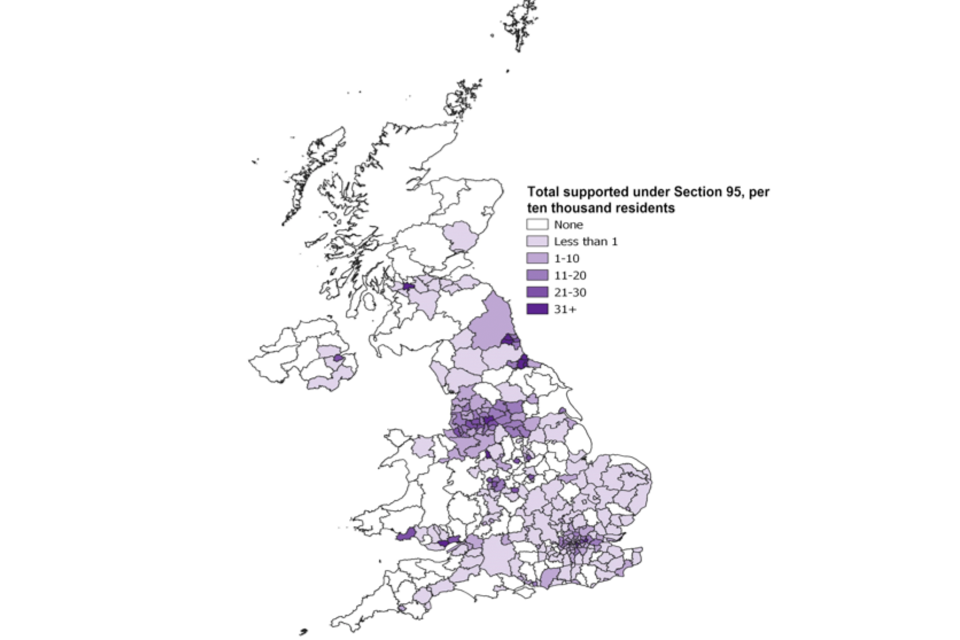
Source: Asylum tables – Section 95 support by local authority
Notes:
-
Includes main applicants and dependants.
-
Local authority data are based on the registered address of the asylum seeker. This is not necessarily the location at which the individual regularly resides. This chart excludes those with an unknown local authority.
-
The “less than 1” category is exclusive of zero.
5. Inadmissibility
In Q1 (January to March) 2021, 1,509 ‘notices of intent’ were served to individuals to inform them that their case was being reviewed in order to determine whether removal action on inadmissibility grounds was appropriate and possible. This more than doubled in Q2 (April to June) 2021 with 3,052 notices being issued.
In the first two quarters of 2021, 7 cases were deemed to be inadmissible, meaning there was sufficient evidence that the asylum applicant had travelled via, or has connections to, another safe third country, and that country will take responsibility for the asylum application. The UK is preparing the return of these applicants.
Over these two quarters, there were no individuals returned on inadmissibility grounds.
Table 3: Number of notices of intent issued under inadmissibility rules and subsequent returns.
| Jan-Mar 2021 | Apr-Jun 2021 | |
|---|---|---|
| Notices of intent issued1 | 1,509 | 3,052 |
| Deemed inadmissible | 2 | 5 |
| Returns | 0 | 0 |
Source: Management information, Home Office
Notes:
-
‘Notices of intent issued’ relate to the number of cases in which a notice was issued over the period.
-
‘Notices of intent issued’ relate to the date the notice was issued, cases ‘Deemed inadmissible’ relate to the date of said decision, and ‘Returns’ relate to the date of return.
6. About the statistics
This section provides information on those applying for and granted protection in the UK through both asylum and resettlement routes. Further data relating to asylum and resettlement can be found in our data tables, and further details on the statistics can be found in the user guide.
The data are used to assess the trends in numbers of people seeking and being granted protection, the impact of policy changes, and to understand the demographics of those coming to the UK to claim protection. Data on resettlement and support, broken down by local authority, can help local authorities understand the demands on their services and resources to aid with planning.
6.1 Asylum, resettlement and protection
Asylum seekers are people who seek sanctuary in another country by applying for asylum – the right to be recognized as a refugee and receive protection and assistance. Asylum seekers will receive a decision on their application, which may be a grant (of asylum, or another form of protection or leave) or a refusal.
Refugees in other countries can also be given protection in the UK via resettlement schemes. The UK works with the UN Refugee Agency (the UNHCR) to arrange for the transfer of refugees from an asylum country to the UK, with the aim of ultimately granting them permanent residence. The statistics in this release do not include the resettlement of over 3,300 Afghan staff (and their families) who have supported British efforts in Afghanistan, since 2013. For further information, see the GOV.UK Factsheet on the resettlement of Afghan nationals.
A family reunion visa allows partners and children of those previously granted asylum or humanitarian protection in the UK to reunite with them here.
The total number of individuals granted protection includes grants related to an asylum application (grants of asylum or alternative forms of leave) and resettlement. Alternative forms of leave include humanitarian protection, discretionary leave, UASC leave, leave outside the rules, and grants under family and private life rules.
Data on asylum applications relate to the period in which the application was lodged, and initial decisions relate to the period in which the decision was made. Initial decisions may, therefore, relate to an application made in an earlier period, and thus the two are not directly comparable.
Data on initial decisions will not reflect the total number of people granted protection through asylum routes as some initial decisions may be overturned following appeal. Data on the number of appeals lodged, and their outcomes, are published in Asylum appeals lodged and determined – Asy_D06 and Asy_D07.
UASC data includes those treated as an unaccompanied minor for at least one day between the date of application and the date of initial decision. Some UASC applicants may subsequently be found to be an adult following conclusion of an age dispute. Data on age disputes are published in Age Disputes – Asy_D05.
Eurostat asylum statistics can be used to compare asylum statistics with EU member states. The methodology used to compile Eurostat data differs from that used in this release; see the user guide for further details.
6.2 Support provided to asylum seekers
Further details on the types of support available can be found in the user guide.
The data show the number of people in receipt of support on a given day, but do not show the length of time for which someone receives support or the amount of support they receive.
6.3 Inadmissibility
The inadmissibility rules provide the grounds for treating an asylum claim as inadmissible to the UK asylum system, if a person has earlier presence in, or connection to, a safe third country. It also provides for the person to be removed to that or another safe third country, with that country’s permission.
From 1 January 2021, following the UK’s departure from the EU, strengthened inadmissibility rules came into effect. Prior to the UK leaving the EU, the Dublin Regulation established the criteria and mechanisms for determining which state was responsible for examining an application for international protection. Further details can be found in the user guide.
Data on inadmissibility are taken from internal Home Office management information and should be considered provisional.
The data relate to the number of notices of intent issued, the number of cases deemed inadmissible and the number of returns under inadmissibility rules. If there is sufficient evidence that an asylum claimant may be eligible for return under inadmissibility principles, they may be issued with a ‘notice of intent’. This informs the claimant how their case is being managed. It does not constitute a formal decision.
Data on transfers into and out of the UK under the Dublin Regulation (prior to the UK leaving the EU) are available in Dub_D01.
7. Data tables
Data referred to here can be found in the following tables:
Additional data relating to asylum, protection and resettlement published in earlier Immigration Statistics releases include:
Statistics on the number of applications and decisions of those applying to enter or remain in the UK under the new Hong Kong British Nationals (Overseas) route are included in the ‘How many people come to the UK each year (including visitors)?’ section.
We welcome your feedback
If you have any comments or suggestions for the development of this report, please provide feedback by emailing MigrationStatsEnquiries@homeoffice.gov.uk. Please include the words ‘PUBLICATION FEEDBACK’ in the subject of your email.
We’re always looking to improve the accessibility of our documents. If you find any problems or have any feedback relating to accessibility, please email us.
See section 7 of the ‘About this release’ section for more details.
